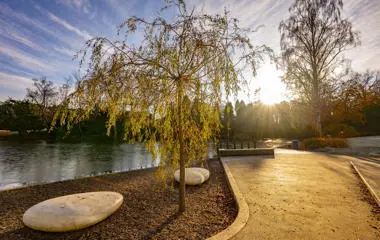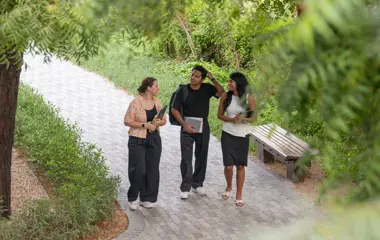Key information
- Funding
- Self-funded
- School
- Energy, Geoscience, Infrastructure and Society
- Location
- Edinburgh
- Delivery type
- Full-time, Part-time
- Start date
- September
The subject of Geomaterials is very broad, and reaches into many other topics that are investigated at the Institute of GeoEnergy Engineering. Our research seeks to understand rocks – and related materials such as concrete, soil, snow, paper, ceramics, and almost all porous materials – in terms of behaviours and properties.
A key concept of research into Geomaterials is that the grain/pore-scale textural arrangements of the solid components and fluid-filled porespaces of Geomaterials determine their physical properties, while also recording the geohistory events and processes that led to their current state. To understand how such processes lead to textural evolution, Geomaterials research both interprets natural rock examples, and also conducts laboratory experiments where the processes can be replicated within controlled conditions.
The Geomaterials group puts a strong emphasis on integrating imaging and measurement techniques to quantify textural evolution and the related physical states. Understanding is then transferred into simulations that allow the knowledge gained to be applied in complex settings.
Research projects
The Geomaterials research group currently works on the following projects:
Localisation of deformation
This topic uses a combination of experimental methods with different resolution and sensitivity to study localisation (e.g. shear and compaction bands, fracturing) in rock samples and synthetic rocks, and characterises the operative micro-processes by full-volume investigations such as: (1) acoustic emission locations and their mechanism types; (2) acoustic tomography; (3) x-ray tomography; (4) neutron tomography; and (5) post-experiment destructive sampling to obtain optical thin sections and SEM images.
Experimental methods are carried out before, during and after the occurrence of localised deformation. We use differencing techniques applied to sequential images to document the onset and evolution of the deformation mechanisms. Moreover, we experimentally investigate the impact of such mechanisms on the spatio-temporal fluid flow within natural and synthetic rock samples (the latter takes place through EU-funded projects performed in European research facilities).
Numerical simulation of faulting
This topic investigates how permanent strain accumulates, and especially how that strain distribution reveals both compactional and dilational volumetric strains, along with highly variable shear strains. The outputs of the simulation have been transformed into predictions of other (emergent) properties, such as permeability and relative permeabilities, as well as acoustic properties. We have been able to directly relate the simulations with experimental outcomes in some cases, as well as applying the knowledge gained to the interpretation of real faults.
Wellbore geomechanics
This topic is examining the validity of common methods used to assess the impacts of wellbore construction, and how that prior state affects other operations such as stimulation.
In-sample sensors
This topic is joint research with colleagues from School of Engineering and Physical Sciences, and focuses on developing nano-sensors that will be introduced into rock samples, or placed into synthetic rocks, to report local states to the experimenter.
Synthetic rocks
This work deals with developing ways to construct controlled rock samples that will allow us to examine porosity, cementation, and grain-arrangements in terms of their impact of deformation responses. It can mix, for example, natural sand grains with synthetic cements and also include nano-sensors in that cement.
Synthetic and experimental diagenesis
This research makes use of methods that have been developed in the Pore-Scale Modelling research group to calculate rock properties as a consequence of diagenetic changes. This strategy has been applied to backstrip observed diagenetic sequences, and to estimate property evolution during burial.
Numerical simulation of flexural-slip and its role in creating fractures
This research is focused on the important role of bedding interfaces as potential mechanical discontinuities. The work has a long history of outcrop investigations, experimental studies, and now, simulations. The simulations require the development of methods to down-scale the continuum responses into probable fracture arrays. The work is associated with fractured reservoirs, and thus has links with the Carbonate Reservoirs research group.
Rock mechanics testing
This topic is pursued with our suite of lab apparatus. We operate two stiff presses into which we can install Hoek cells of SMART cells, which impose radially-differential confining pressures. We also have a large-sample direct-shear machine, with capability of measuring fluid flow both parallel and normal to a shear plane. There is also a soil mechanics rig. We are also completing development of a large-sample enhanced version of the SMART cells, jointly with University of Edinburgh and University of Göttingen.
Geomechanics at high pore pressure
This work examines, and challenges, classical ideas about the interaction of fluids and mechanics at extreme conditions. It has developed an energy-based reformulation that has proven useful for deriving new understanding of the responses of caprocks, and in situations of natural or induced hydraulic fracturing.
Entry requirements
Candidate criteria
Please contact the institute to discuss.
English language requirements
If your first language is not English, we'll need to see evidence of your English language ability.
The minimum English language requirement for entry to this programme is IELTS 6.5 (or equivalent) with no score lower than 6.0.
If you do not have IELTS 6.5, we offer a range of English language courses to help you meet the English language requirement for this programme prior to commencing your studies.
For more information about your application and our English Language requirements, please see Section 10 of our page on English Language Requirements as part of your application.
Funding information
| Status | Full Time | Part Time |
|---|---|---|
| Scotland | £5,151 | £2,575.50 |
| England / Wales / N Ireland | £5,151 | £2,575.50 |
| International | £20,456 | £10,228 |
- Status: Your residency status is usually defined as the country where you have been ordinarily resident for the three years before the start of your course.
- International: 'International' includes applicants from European Union countries who do not hold Pre-Settled or Settled status in UK. (This does not include students from the Republic of Ireland - see above).
We offer a number of competitive funded scholarships for research degrees. Full or partial support may be available for well-qualified candidates from UK research councils, research pools, charities or industry.
View our full range of scholarships.
Why Heriot-Watt
We're the top university in Scotland for graduate outcomes which means that more of our graduates are employed or in postgraduate education than any other institution in the country and we ranked 5th in the UK.
We're also rated number one in the UK for CEO or MD roles, meaning more of our graduates go on to become CEOs or MDs than any other university in the whole of the UK. On top of that, we have beautiful campuses, across the globe, so you'll get a truly international education. Our Edinburgh Campus is home to Oriam, Scotland's National Sports Performance Centre combined with plenty of wellbeing resources, prioritising fitness and mental health for all students. Our Global Research Institutes look at solving real world issues such as climate change and saving our oceans as well as working on the next medical technological breakthrough and the future of AI and robots.
Related content
Explore facilities, & chat to staff and students


